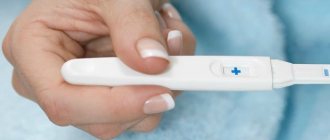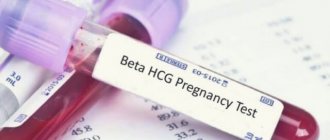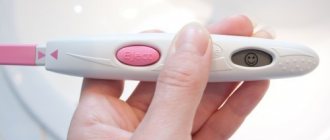A woman who is pregnant at an early stage does not always have pronounced signs of the birth of a new life in her. Sometimes the first hints of an “interesting situation” appear only after a delay. And even then not always.
Therefore, often ladies for whom conceiving a baby is a desired event do not like to wait long and decide to check their situation by doing a pregnancy test after ovulation. The same haste is characteristic of girls who do not want a child. Can you always trust the result of a test done before the delay?
How does the test work?
The essence of any pregnancy test is that it detects the amount of hCG hormone in the urine. This name stands for human chorionic gonadotropin. It is produced as soon as the embryo is fixed in the uterus (then the growth of the placenta begins, which in the future will protect the child from the negative influences of the environment, nourish it and remove waste).
With each day of gestation, the amount of hCG in the pregnant woman’s body increases. But even at the earliest stages, you can donate venous blood. This test helps determine pregnancy 5 days earlier than pharmacy pregnancy tests for home use (even the best ones) give an answer. Most home tests detect hCG once levels reach 25 mUI or higher.
On some boxes you can see that the test sensitivity is higher (10 mUI). But is this really so? Some pharmacists consider this inscription a commercial move (after all, with such a test it is supposedly possible to determine earlier whether you are pregnant). It is also not entirely true that the inscription that the accuracy of determining pregnancy before a missed period is 99.5-99%.
How are pregnancy tests designed and how do they work?
All pregnancy tests have a fairly simple operating principle. They are equipped with special indicators that notify the woman about an “interesting situation.” It is very easy to conduct research and evaluate the results at home. Any test has a reagent that is sensitive to human chorionic gonadotropin. This hormone begins to be produced in a woman’s body immediately after conception, but its level in the urine increases gradually. It is urine that will be required for the study. When it accumulates the concentration of the hormone that allows the test to react, it will give a positive result. Accordingly, when there is little hormone in the urine, the test answer will be negative.
A reliable result can almost always be obtained on the first day of a missed period. All test manufacturers indicate that the accuracy of their instruments is 99% if the testing procedure is carried out within the specified time frame and the instructions are strictly followed.
Many modern testing systems make it possible to determine pregnancy a few days before the expected onset of menstruation, but this does not mean that conception can be diagnosed 1-2 days after intercourse. The hCG hormone begins to be produced in large quantities only a week or more after the egg has been fertilized. However, the level of gonadotropin in the urine 7 days after conception will still be insufficient for the test to give a positive result. However, starting from the next week, the level of hCG increases several times and, using tests with increased sensitivity to this hormone, it will be possible to determine the presence of pregnancy.
Regular cycle tests
A regular cycle means that you always have the same number of days of your period and a break in between. That is, from the beginning of menstruation to the beginning of subsequent periods, 22-30 days pass. With a stable menstrual cycle, the egg is released in the middle of the cycle. If your menstrual cycle is 30 days, then you will ovulate on the 15th day. With a 28-day cycle, ovulation normally occurs on the 14th day.
Within two days after the release of the egg, the probability of pregnancy is highest. If conception occurs during this period, then the fertilized egg takes 4-5 days to reach the uterus, where an anchorage will be formed. This means that a blood test will show an increase in hCG only on the 22nd day of the cycle.
The best pregnancy tests can show you a positive result 4 days before your period. At this time, the level of human chorionic gonadotropin exceeds 25 mUI. A highly sensitive pregnancy test can be done on the 26th day of the monthly cycle if the total number of days in the cycle is 30. If the cycle is 28 days, then the test can be done on the 24th day.
When to take a pregnancy test
You are more likely to get an accurate result if you take a pregnancy test after a missed period. And that's why. All home tests work according to the same scheme: they contain a substance that changes color when it interacts with the hormone human chorionic gonadotropin. It is abbreviated as hCG, informally - pregnancy hormone.
HCG is produced by the membrane of the fertilized egg as soon as it attaches to the wall of the uterus. This does not happen right away. First, conception itself must take place, and this is only possible during the fertile window.
The fertile window usually “opens” 2-3 days before ovulation and “opens” another day after it. During ovulation, a mature egg is released from the follicle and is ready to “meet” the sperm. But she won’t have to wait long - on average from 12 to 24 hours.
Then, if the meeting does not take place, she will die. But sperm can “come on a date” in advance and wait in the fallopian tube for 2-3 days. Particularly persistent ones can survive from 5 to 6 days. So conception can happen a week after sex.
The egg and sperm unite, exchange genetic information and form a new cell - a zygote - with a unique set of DNA. The zygote immediately sets off on a journey: at least a three-day route with the destination being the uterine cavity.
Having arrived, the zygote turns into a blastocyst and floats for some time, trying to attach to the wall of the uterus. As soon as she succeeds and she goes deeper into the uterine layer, the pregnancy is considered successful. From this moment on, the female body produces the hCG hormone. First it appears in the blood, then in the urine. Every day its concentration increases 2 times. But hCG reaches a level that can be detected by a rapid test only on days 10-12.
Now we count. Ovulation occurs in the middle of the cycle. So, if the cycle is 28 days, the egg will be released from the follicle on the 14th day. She will wait a day for fertilization. Travel for another 3 days until it reaches the uterus. Approximately 2 days of trying to implant into her endometrium. Plus 12 days for the hCG concentration to reach a noticeable level.
So it turns out that it is preferable to do the test from the 4th day of the delay. It is at this time that there will be a greater chance of getting an accurate result.
Unstable cycle tests
Today's pace of life, ecology and peculiar view of sexual relations lead to the fact that the cycle of many girls and women is not stable. Between menstruation there can be from 19 to 35 days (or more/less in rare cases, which indicates serious disorders in the body), and each time the figure will be slightly different.
If you have an unstable cycle, then ovulation is determined by special tests. You can also find out ovulation by the appearance of symptoms of premenstrual syndrome (PMS) or measure your basal temperature (the readings will be elevated). When you find out the date of ovulation, add another 12 to this day - then the test will give the correct result due to the increase in hCG in the blood during pregnancy. If you have an irregular menstrual cycle, the answer to the question “when to take a pregnancy test”: 15 days after ovulation (the release of the egg).
Is it possible to find out about pregnancy before the delay?
Sometimes the test signals an interesting position with two stripes even before the delay occurs. This is due to the fact that each organism is unique and each pregnancy develops according to its own plan, deviating from the average time frame. Ovulation may occur a little earlier than expected, the sperm will “meet” the egg as soon as it is released, the zygote will reach the uterine cavity faster and implant just as quickly, and hCG will rise to a high level sooner than usual.
So, if you don’t have patience, and you really want to know the result, you can test on the 24th day of the cycle. It makes no sense before. You just need to understand that now the test may not show a second strip, but this will be done when you retest in a couple of days.
To quickly find out about pregnancy, experts also advise:
- take a pregnancy test in the morning, when the urine is concentrated and contains the maximum level of hCG;
- do not “dilute” the urine - do not drink a lot of liquid the day before, do not take any diuretics;
- choose highly sensitive tests: the label should say 10–15 mIU/ml. Standard tests only detect hCG if levels rise above 25 mIU/ml;
- do a laboratory blood test, which will indicate that you are expecting a baby about 4 days earlier than the home rapid test. After all, the level of hCG in the blood increases faster than in the urine.
What time of day should I take the test?
In most cases, you will not find this information in the test instructions. This means that the time of day does not affect the test performance. But doctors advise using test strips after waking up, before you have ever gone to the toilet. This will give the most reliable results.
During daytime testing, there may be an error due to a reduced concentration of the hormone in the urine, because you drink liquid all day. It is also better to refuse to take a pregnancy test in the evening, postponing the procedure until the morning. If you have the opportunity to carry out the test only during the day, then 4 hours before the procedure, do not go to the toilet “smallly” and do not drink water or other drinks (or drink very little). This will make the urine more concentrated, and the test will show pregnancy, if any.
What is the effect of a pregnancy test based on?
The menstrual cycle and a woman's entire life are controlled by hormones. They predetermine not only the possibility of conception, but also the psycho-emotional state, as well as health. The initial stage of the cycle is controlled by the hormone estrogen; after ovulation, progesterone takes over. The balance of these hormones ensures the normal functioning of the female body, its readiness for ovulation and conception.
The pituitary gland produces another secretion - human chorionic gonadotropin (hCG). Its natural content is usually around 5 mIU/ml. The hormone is produced in large quantities by the fetal placenta, which is why it is called a hormone or pregnancy marker. In the first third of the period, the amount of gonadotropin in the body increases very quickly.
In case of conception, the hormone content rises to 25 mIU/ml within two weeks. It is the content of hCG in the urine that determines conception in pregnancy tests. This hormone is present in human blood and urine. Since the blood level is higher and laboratory methods are more accurate, if you are very impatient, you can donate blood to determine pregnancy in the laboratory.
The use of test strips is based on measuring the content of gonadotropin in urine. How many days after ovulation you can take a pregnancy test is determined by the number of reagents applied to the strip. Most tests detect hormone concentrations within 25 mIU/ml.
Determining pregnancy at home using test strips is very convenient and has a high degree of reliability. Testing can be done at a convenient time. However, when the concentration of the hormone is still low, that is, in the early stages, for greater reliability it is better to do this in the morning, when the hCG content is maximum.
Important: before using the tester, you should read the recommendations in the attachment. Following the prescribed rules will ensure the accuracy of the result and help avoid disappointments and mistakes.
If it is recommended to use the strip some time after the expected start of menstruation, it means that the manufacturers know that the amount of the reagent is not enough to detect conception earlier.
A necessary condition is to ensure the required volume of urine and time of contact with the strip. Those who are anxious to find out about conception need to remember that in the evening you should try not to drink a lot of fluids and not use diuretics.
Testing error is possible in both directions – positive and negative.
An incorrect positive result is obtained:
- When using certain medications.
- Immediately after the abortion.
- In the presence of neoplasms.
Testing will not correctly detect pregnancy if:
- too early use, low concentration of hCG is not detected by the reagent;
- changes in the composition of urine due to excessive consumption of fluids or medications;
- in the case of kidney or heart disease, it will be easier to detect conception by blood.
On what day after ovulation the test will show pregnancy depends on the test and other factors. If you use an inexpensive option with two stripes, then the pale second stripe, confirming conception, may be dim due to early use and insufficient concentration of hCG in the urine. Repeated testing after some time will confirm or deny conception.
More expensive test options allow you to determine the concentration of the hormone with 10 mIU/ml, that is, several days earlier than the cheap ones. The woman decides which means to use.
How to use a pregnancy test
- Make sure that home use test strips are stored as directed.
- If you purchased the test in damaged packaging, do not use it.
- Expired pregnancy tests will also give unreliable results, because when purchasing, pay attention to the date.
- It is strictly prohibited to use the same test strip twice. This way you will not get reliable results.
- As noted above, it is better to do the test after waking up, during the first time you empty your bladder after the night.
- The pregnancy test package is opened before use. Don't open it in advance!
- Before doing the test, wash yourself and dry with a towel. Use a clean container to collect urine. This could be a disposable cup.
- Follow the instructions on the package. Dip the strip into the urine to the level indicated on the strip. Do not keep the strip in urine for more than what is written on the package (a few seconds).
- The result is assessed after 3-5 minutes (this may be a different time, read the instructions carefully).
Pregnancy test and late ovulation
The average woman has a menstrual cycle of 28 days. Ovulation occurs in this case on the 14th day. But for some women, the cycle can be up to 40 days. In this case, it is very difficult to plan conception, since ovulation is late, and it is practically impossible to calculate when it will occur. Only in rare cases does this anomaly occur throughout life, which is why for some it is the norm and an individual characteristic of the body.
Often, an increase in cycle duration occurs for the following reasons:
- diseases of the endocrine system (hormonal imbalances);
- sexual infections;
- gynecological diseases;
- premenopausal period.
Can a woman get pregnant with a long cycle and late ovulation? The answer is definitely yes, but the couple will have to try. In order to calculate favorable days for conception, you need to track ovulation for three cycles by measuring basal temperature. There is a special article about this on our website: Basal temperature after ovulation.
But why doesn’t a pregnancy test show anything when ovulation has taken place and conception is very likely? This happens because ovulation in such cases may occur shortly before menstruation, and the woman buys the test without waiting for her period. Due to the fact that the alleged conception occurred only a few days ago, the concentration of hCG is still too low to be detected by the test. Therefore, it is necessary to wait 2-3 weeks for the level of the hormone to increase in the body and become sufficient to determine pregnancy.
With late ovulation, which occurs on the eve of menstruation, there are cases when menstruation occurs as usual, despite conception having taken place. In such a situation, it can be very difficult to determine the duration of pregnancy.
Although women with late ovulation have difficulty recognizing pregnancy, this does not in any way affect their well-being during pregnancy and childbirth.
Types of tests
Today, the most accurate and widely used are Evitest and Frautest. They are made in Germany and are affordable. The remaining tests should be considered reliable if you used them correctly and on time. The most accurate results are obtained if you are tested in the first 1-3 days after the delay of critical days. Remember that the low cost of a home pregnancy test is due to the cheap reagents that are used in it.
Strip test
- Evitest №1
- FRAUTEST Express
- Femitest Practical
- Secret
- Femitest Practical Ultra
- BBtest
- Itest Plus
- Eve
These are budget tests, which are a strip on which a layer of antibodies to hCG is applied. If you are pregnant, you will see two lines on the test strip. Instructions: take a clean container and collect 10 or more ml of morning urine into it. Lower the test strip with the correct side to the clearly indicated level and hold for 10 seconds (or other amount of time specified in the instructions).
The result will be visible within 1-10 minutes. If the level of hCG in the urine is just starting to rise, then the second strip will definitely not appear in the first minutes. Remember that any pregnancy tests, especially strip tests, can give false results.
Tablet pregnancy tests
- Evitest Proof
- Frautest Expert
- KnowNow optima
- Sezam
- Clearblue
- Femitest handy
- LadyTest-C
The test is a box with two windows. The kit you purchase will include a pipette and a container for collecting urine. Instructions: drop 4 drops of your urine into the indicated window. The result will appear in the second window after a few minutes (read the exact time on the packaging or in the instructions for the purchased test).
These tests show correct results from the first day of your missed period. It is not rational to use it before the delay, because you will not get reliable results either. The downside of these tests is also that they are more difficult to use than strip pregnancy tests, which we wrote about just above.
Inkjet tests
- Clearblue
- Femitest jet ultra
- Frautest comfort
- Clear view
- FRAUTEST EXCLUSIVE
- Evitest Perfect
- Duet
No urine collection is required for this test. You will need to place it under the stream of urine while going to the toilet “little by little.” Instructions: hold the test under running urine or in a container with urine with the indicated end for 10 seconds. This may be a different immersion time; carefully check your manufacturer's instructions. The result is assessed in 1-10 minutes, and no later. It will be visible in the window. If you are pregnant, the test will show 2 lines.
Manufacturers promise that the test is so sensitive that it can be used 5 days before the expected delay of menstruation. Inkjet tests are considered more accurate and reliable than strip tests for home use. But their main disadvantage is their high cost.
Electronic tests (digital)
- ClearBlue digital
- Test with Pteq USB connector
This is the newest development. Instructions: Dip the test tip into the urine with the indicated tip (where the filter is located) until it is saturated. The result will be visible after 3 minutes. A special window will display the inscription “pregnansy” or a plus sign in case of pregnancy. These tests are considered to indicate pregnancy when there are still 4 days left before the missed period.
Its accuracy is 99% if tested 2 days before the planned critical days. Electronic or digital pregnancy tests are the most sensitive to the “pregnancy hormone”. The result can be seen in the window for about 24 hours, then the inscription is erased, and you will not be able to save the test as a memory. This category of tests is expensive.
Negative tests
Many people are concerned about whether tests for home use can show a false negative result, and when there is such a possibility. The level of human chorionic gonadotropin (which is released when a fertilized egg attaches to the uterus) increases at different rates for everyone.
For some, 2 weeks pass from the day of the delay, and the test shows a negative result. This happens if there is a threat of miscarriage, or the expectant mother has endocrine gland dysfunction. If you use the test immediately after unprotected sexual intercourse, you will also receive a negative result. Firstly, conception may not have happened yet. Secondly, to obtain reliable results, several days must pass from the moment of conception.
A negative pregnancy test result can be obtained if it is used incorrectly:
- put it down the wrong way
- collect urine in the evening or morning
- apply an expired test, etc.
The test may also show a positive result if there has been no conception. This result is called a false positive . Causes:
- ovarian dysfunction
- period 2 months after birth
- overdue test
- growth in a woman’s body of a tumor that produces hormones (hydatidiform mole, chorionic carcinoma)
Tests for ectopic pregnancy
An ectopic pregnancy is diagnosed when the fertilized egg is not implanted in the uterus. Basically, consolidation during an ectopic pregnancy occurs in the fallopian tube. But even with this process, a pregnancy hormone is produced, to which the tests are sensitive. In some cases, the increase in hCG may not be detected, or it will be too small for tests to detect it. There is a chance of a false negative result, but it is negligible. Most tests for ectopic pregnancy show a positive result.
You may see that the second line is blurry or very faint, but it will be there. Positive results are shown by tests for ectopic pregnancy only after a woman’s period has been delayed. The INEXSCREEN test has been developed, which diagnoses ectopic pregnancy when approximately 14 days have passed from the first day of the delay.
Pale second stripe
Often, after receiving the results, women do not understand whether there is a second line or not. Sometimes it is faintly visible. If you twist the test, it seems that it appears and then disappears. The reason may be that the hCG level has increased, but it is not yet high enough to be detected by the test. To recheck the result, take a test in a week or go for an ultrasound to a gynecologist.
The second line may not be clear if you did not use the test properly. You can read the instructions again, understand your mistakes and repeat the test. But in some cases, the reason for the second stripe may be the woman’s psychological desire to be pregnant. That is, she will see a second stripe where there is actually none.
If you receive a questionable result, as already noted, you can be tested again after a few days. But it is better to carry out the test 1-2 days after the missed period. Confirmation is carried out using ultrasound diagnostics.
The worst pregnancy tests are also identified by experts. It's better not to use them. This:
- rest assured
- Faith
- Mon Ami
- Bebicek
- Bee-Sure











